| Karachi Harbour | |
|---|---|
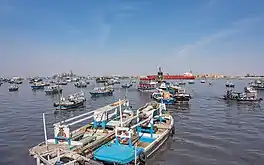 A view of the harbour with the Port of Karachi visible | |
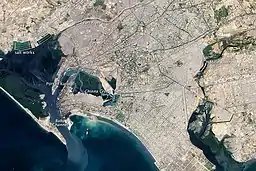 | |
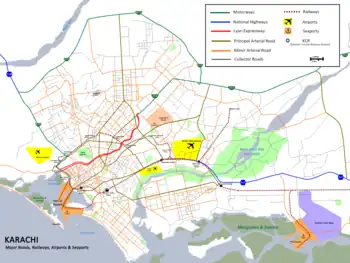 Karachi Harbour | |
| Location | Karachi, Pakistan |
| Coordinates | 24°48′55.2″N 66°58′08.4″E / 24.815333°N 66.969000°E |
| River sources | Lyari River |
| Ocean/sea sources | Arabian Sea |
| Basin countries | Pakistan |
| Islands | Baba and Bhit Islands |
| Settlements | Baba and Bhit villages Karachi Kakapir Manora Shamspir |
Karachi Harbour is a narrow bay and river estuary located west of the Indus River Delta in Karachi, Pakistan. The harbour lies between the Lyari River delta and Chinna Creek to the north, and the Arabian Sea to the south. Since 1886,[1] sections of the harbour have been improved to form the Port of Karachi - Pakistan's busiest seaport.[2]
Geography
The harbour is divided into an Upper and Lower Harbour, which together have a length of 11.5 kilometers.[1] The Upper Harbour has been developed into the Port of Karachi, and is located between the East and West Wharfs of the port,[3] where it then goes on eastward to form a series of backwaters with thick mangrove forests known as Chinna Creek. Along the western edge of the West Wharf is a small local fishing harbour known as the Karachi Fish Harbour, built in 1958,[1] and the delta of the Lyari River. The Lower Harbour, also known as Baba Channel, stretches from Manora and Keamari to the port,[3] and serves as a shipping channel between the port and the Arabian Sea.
History
Nearchus, who commanded Alexander the Great's naval fleet, mentioned a hilly island by the name of Morontobara and an adjacent flat island named Bibakta, which colonial historians identified as Karachi's Manora and Keamari (or Clifton), respectively, based on Greek descriptions.[4][5][6] Both areas were island until well into the colonial era, when silting in led to them being connected to the mainland.[7]
In 711 CE, Muhammad bin Qasim conquered the Sindh and Indus Valley and the port of Debal, from where he launched his forces further into the Indus Valley in 712.[8] Some have identified the port with Karachi, though some argue the location was somewhere between Karachi and the nearby city of Thatta.[9][10]
Under Mirza Ghazi Beg, the Mughal administrator of Sindh, the development of coastal Sindh and the Indus River Delta was encouraged. Under his rule, fortifications in the region acted as a bulwark against Portuguese incursions into Sindh. Karachi is also mentioned in the sixteenth century Turkish treatise Mir'ât ül Memâlik (Mirror of Countries, 1557) by the Ottoman captain Seydi Ali Reis, which warns sailors about whirlpools and advises them to seek safety in "Kaurashi" harbour if they found themselves drifting dangerously.[11][12][13]
In 1728 heavy rains silted up the harbour at Kharak, forcing merchants to relocate to the area of modern Karachi. 19th century Karachi historian Seth Naomal Hotchand recorded that a small settlement of 20–25 huts existed along the Karachi Harbour that was known as Dibro, which was situated along a pool of water known as Kolachi-jo-Kun.[14] In 1725, a band of Balochi settlers from Makran and Kalat had settled in the hamlet after fleeing droughts and tribal feuds.[15] A new settlement was built in 1729 at the site of Dibro, which came to be known as Kolachi-jo-Goth ("The village of Kolachi"),[16] which grew into the modern city. The gate facing the sea was called "Kharadar" (salt gate), and the gate facing the Lyari River[17] was called "Mithadar" (sweet gate). From 1729 to 1783 the strategic location of Kolachi saw the town change hands several times between the Khans of Kalat and the rulers of Sind. In 1783, after two prolonged sieges the town fell to the Talpur Mirs of Sind, who constructed a fort mounted with cannons on Manora island at the harbour entrance.[18]
The British East India Company captured Karachi on 3 February 1839 after HMS Wellesley opened fire and quickly destroyed Manora Fort, which guarded Karachi Harbour at Manora Point.[19] Karachi was recognized for its strategic importance, prompting the British to establish the Port of Karachi in 1854. Karachi rapidly became a transportation hub for British India owing to newly built port and rail infrastructure, as well as the increase in agricultural exports from the opening of productive tracts of newly irrigated land in Punjab and interior Sindh.[20] At the outbreak of the American Civil War, Karachi Harbour became an important cotton-exporting port,[21] with Indus Steam Flotilla and Orient Inland Steam Navigation Company established to transport cotton from interior Sindh to the harbour, and onwards to textile mills in England.[22]
With the completion of the Suez Canal in 1869, Karachi's position as a major port increased even further.[21] In 1878, the British Raj connected Karachi with the network of British India's vast railway system. In 1887, Karachi Port underwent radical improvements with connection to the railways, along with expansion and dredging of the port, and construction of a breakwater.[21]
Island settlements
Baba and Bhit Islands
Baba and Bhit are two small and densely populated islands located in the Karachi Harbor, near Karachi.[23] The approximate area of the islands is 4 km² and the population is about 25,000. The islands are connected to Karachi via a ferry service to Keamari.[24]
Kakapir
Kakapir is a fishing village in Karachi Harbour, 15 kilometers west of Karachi.[25] It is located at the western end of Sandspit Beach, near Hawke's Bay Beach. Mauripur lies to its north. Kakapir is named for a saint, whose shrine is located in the village, who reportedly was known for his brown hair.[26] The village is reportedly about 100 years old.[25] Residents of the village were originally from the Mithadar and Kharadar neighborhoods of Karachi, who were settled by the British in Shams Pir during the construction of the Port of Karachi.[26] Those residents migrated further west and established Kakapir.[26]
Shams Pir
Shams Pir is an island village near Karachi, Pakistan, along the western end of Karachi Harbour, close to Sandspit Beach and Kakapir.[27] The village is bordered by thick Mangrove forests which grow in the harbor.[28]
Gallery
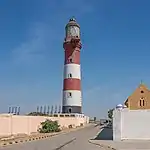 Manora Point Lighthouse at the entrance to the harbor
Manora Point Lighthouse at the entrance to the harbor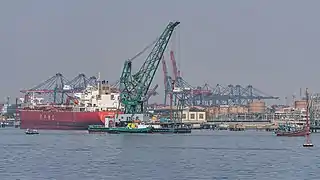 Cranes at the Port of Karachi
Cranes at the Port of Karachi Kiamari's Sydenham Passenger Pavilion, located in the lower harbour
Kiamari's Sydenham Passenger Pavilion, located in the lower harbour
References
- 1 2 3 Ali, Mahvash Haider, ed. (2016). A Handbook on Pakistan's Coastal and Marine Resources (PDF). Mangroves for the Future, Pakistan. ISBN 978-969-643-019-3.
- ↑ Sánchez-Triana, Ernesto; Afzal, Javaid; Biller, Dan; Malik, Sohail (2013-07-18). Greening Growth in Pakistan through Transport Sector Reforms: A Strategic Environmental, Poverty, and Social Assessment. World Bank Publications. p. 33. ISBN 978-0-8213-9930-9.
- 1 2 Notice to Mariners. Defense Mapping Agency Hydrographic/Topographic Center. 2001.
- ↑ Vincent, William (1797). The Voyage of Nearchus from the Indus to the Euphrates, Collected from the Original Journal Preserved by Arrian ...: Containing an Account of the First Navigation Attempted by Europeans in the Indian Ocean. T. Cadell jun. and W. Davies. p. 180.
- ↑ Houtsma, M. Th (1993). E. J. Brill's First Encyclopaedia of Islam, 1913–1936. BRILL. ISBN 978-90-04-09790-2.
- ↑ Lambrick, H. T. (1975). Sind: A General Introduction. Sindhi Adabi Board. ISBN 978-0-19-577220-3.
- ↑ Pithawalla, Maneck B. (1950). An Introduction to Karachi: Its Environs and Hinterland. Times Press.
- ↑ Archived 24 September 2013 at the Wayback Machine
- ↑ Cunningham, Alexander (28 March 2013). The Ancient Geography of India: The Buddhist Period, Including the Campaigns of Alexander, and the Travels of Hwen-Thsang. Cambridge University Press. ISBN 978-1-108-05645-8.
- ↑ Elliot, Henry Miers (1853). Appendix to the Arabs in Sind, Vol.III, Part 1, of the Historians of India [sic]. S. Solomon & Company. p. 222.
- ↑ Bloom, Jonathan; Blair, Sheila (2009). Grove Encyclopedia of Islamic Art & Architecture: Three-Volume Set. OUP USA. ISBN 978-0-19-530991-1.
- ↑ Baillie, Alexander Francis (1890). Kurrachee: (Karachi) Past, Present and Future. Thacker, Spink.
- ↑ Balocu, Nabī Bak̲h̲shu K̲h̲ānu (2002). Sindh, Studies Historical. Pakistan Study Centre, University of Sindh. ISBN 978-969-8135-13-3.
- ↑ Haider, Azimusshan (1974). History of Karachi: With Special Reference to Educational, Demographical, and Commercial Developments, 1839–1900. Haider.
- ↑ Gayer, Laurent (2014). Karachi: Ordered Disorder and the Struggle for the City. Oxford University Press. ISBN 978-0-19-935444-3.
- ↑ Askari, Sabiah (2015). Studies on Karachi: Papers Presented at the Karachi Conference 2013. Cambridge Scholars Publishing. ISBN 978-1-4438-7744-2. Retrieved 30 October 2016.
- ↑ 5 Things You Probably Didn't Know About Lyari (info about Lyari River) hamaralyari.com website, Retrieved 5 January 2018
- ↑ "Ecologically destructive projects on Karachi coast". Dawn Group of Newspapers. 27 November 2006. Retrieved 5 January 2018.
- ↑ Neill, John Martin Bladen (1846). Recollections of Four Years' Service in the East with H.M. Fortieth Regiment. Retrieved 27 November 2009.
- ↑ Blood, Peter R. (1996). Pakistan: A Country Study. DIANE Publishing. p. 96. ISBN 978-0-7881-3631-3.
- 1 2 3 Heitzman, James (31 March 2008). The City in South Asia. Routledge. p. 129. ISBN 978-1-134-28963-9.
- ↑ merchant.), S. H. Clarke (East India (1858). The Scinde Railway and Indus Flotilla Companies: Their Futility and Hollowness Demonstrated, Also an Exposure of the Delusion which Exists Respecting the Five Per Cent Guarantee, which Insures No Dividend Whatever to the Respective Shareholders. Richardson Brothers.
- ↑ Kiamari Town - Government of Karachi Archived 2006-02-19 at the Wayback Machine
- ↑ Hasan, Shazia (2013-06-27). "Overloaded boats continue to ferry people between city and islands". DAWN.COM. Retrieved 2020-04-19.
- 1 2 "Empowering Fisherfolk Women". www.mangrovesforthefuture.org. Retrieved 2020-04-19.
- 1 2 3 "Study on Knowledge, Attitudes, & Practices of Fisherfolk Communities" (PDF). World Wildlife Foundation. 2005.
- ↑ "Shams Pir Island gets". www.thenews.com.pk. Retrieved 2020-04-19.
- ↑ "KARACHI: Mangroves disappearing off Shamspir Island". DAWN.COM. 2006-12-14. Retrieved 2020-04-19.